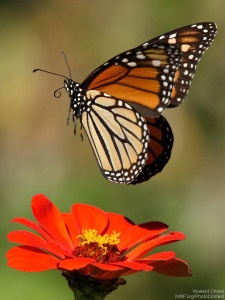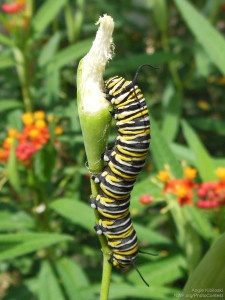We have much more to do and your continued support is needed now more than ever.
Monarchs Face New Threats, Losses Along Migration Route
The monarch butterfly has always been the most popular, recognizable and well known species of its kind. With its stunning bright orange wings and black and white markings, these butterflies bring smiles to people across the United States during their annual migrations. Recent news about the monarch however, has left me frowning instead of smiling.

Western monarchs are not too far behind with the decline, California monarchs have also been noted to have a drastic decline over the years. Numbers that reached 1,235,490 in 101 different California sites have dropped to an all time low of 144,650 in 2012. While the numbers of monarchs to arrive in California in 2013 are still being calculated, it is speculated the number for the year will be a severely low number.
What is causing these butterflies to decline in such an alarming rate?

Changes in Weather and Climate Change
Extreme weather conditions are causing a disturbance in monarch migration. Normally, as monarchs travel south toward Mexico, they feed on nectar from late blooming wildflowers—such as goldenrod—and various species of sunflower. With extreme heat and droughts, their food supply is being compromised. Droughts in Texas have led to wildfires, which in turn have destroyed much of the milkweed habitat. This decline of the monarchs’ food source and habitat reduces the chances of butterflies making it to their winter migration homes.
In California, our western monarchs are dealing with similar issues. When hillsides are too dry and much of their food supply is being burned down, monarchs are found without a reliable source of food. Studies show that climate change will create more disruptions to the monarch’s migration patterns by affecting weather conditions along its migration routes.
Midwestern Agriculture
According to researchers, the biggest and most critical factor in the decline is the expansion of cropland and a big increase in the use of genetically modified crops that are resistant to herbicides, which in turn has led to more herbicide use against native plants that compete with crops. This crop expansion is happening in grassland ecosystems all over the United States, especially California, where western monarchs usually breed and feed. But because these herbicides are killing seedlings that are still developing as well as the perennial plants, the only host plant for monarch caterpillars, milkweed, is disappearing along with the nectar plants used by adults. What are we to expect of these beautiful butterflies if we are destroying their only form of food?
Illegal Deforestation
Over the past several decades, logging in Mexico has destroyed large swaths of the country’s forests, including the few sites where monarchs overwinter. With such heavy impacts, the Mexican government ruled logging illegal several years ago. However, illegal logging is still occurring, leaving monarchs with less and less suitable winter habitat.

What can you do to help?
The future of the monarch butterfly may seem dire, but if you’re anything like me, you will fight to keep them from facing extinction. Lucky for monarchs, there are ways you can help. Gardening for wildlife is a great way to help provide food, water, shelter and place to raise young for all types of wildlife.
For monarchs, you can plant native flowering plants, especially milkweed, to help feed these beautiful butterflies! Learn how your garden can help the survival of monarchs and other wildlife.
Not sure where to start? NWF offers milkweed and other native plants through our American Beauties Native Plant program for gardeners searching for species and retailers in their area.




















